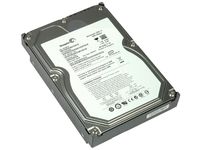Tom’s Winter 2008 Hard Drive Guide
Seagate: Barracuda 7200.11
Be careful when purchasing a Seagate Barracuda 7200.11 drive, as there are two different models on the market. Go to the Seagate Web site and check out the product family page for details. Be sure to get one of the drives based on the latest technology, which allowed Seagate to reach 1.5 TB maximum capacities.
1.5 TB Top Model (ST31500341AS)
We have not received another hard drive that matches the capacity of the new Seagate Barracuda 7200.11 1.5 TB. While it is called a Barracuda 7200.11 like the previous drives that reached one terabyte, the latest products are based on increased storage densities. As a result, there are different models at other capacities available as well. Be sure you get the latest model version if you want maximum performance. The new 7200.11 drives come with the usual 7,200 RPM spindle speed, a SATA/300 interface, and 32 MB of cache. If you go for a lower capacity model you may get a drive with less cache memory, but this should not make much of a difference in everyday use.
The 1.5 TB drive provided quick access time, but only average I/O performance. Power consumption results weren’t impressive either, which resulted in average performance per watt results, despite this drive’s impressive throughput numbers: 127 MB/s is the best transfer rate we’ve ever measured on a 3.5” 7,200 RPM desktop hard drive, so the 1.5 TB drive beats every other 3.5” model in this review. If you look at the total capacity per watt, then Seagate still provides good efficiency results—at least until some other drive maker releases a 1.5 TB drive that requires less power.
1.0 TB Mainstream (ST31000340AS)
The 7200.11 at 1 TB was Seagate’s first drive to reach this impressive capacity, but Hitachi and WD were quicker with releasing hard drives at this capacity point. At the time the Barracuda 7200.11 hit the market, it offered the best mix of capacity, performance and cost. WD was available with a lower power drive, and Hitachi already had a disadvantage due to its lower recording density. Today, we recommend against the first-generation Barracuda 7200.11 1 TB (ST31000340AS), as the updated model (ST31000333AS) delivers greatly increased performance with lower power consumption.
We measured a maximum throughput of roughly 100 MB/s for the ST31000340AS Barracuda 7200.11 1 TB, which could almost be matched by WD’s new Caviar Green WD10EADS drive. Every other modern terabyte drive provides more throughput. Its 12.7 ms access time is still a good result, which is reflected by acceptable I/O performance numbers. The 6.8 W power consumption and the performance per watt results for streaming reads and workstation I/O are average, but not special anymore. Again, make sure you go for the newer ST31000333AS, as it delivers the performance of the 1.5 TB top model.
Get Tom's Hardware's best news and in-depth reviews, straight to your inbox.
Current page: Seagate: Barracuda 7200.11
Prev Page Samsung: Spinpoint F Next Page Western Digital: Mainstream and Low Power


